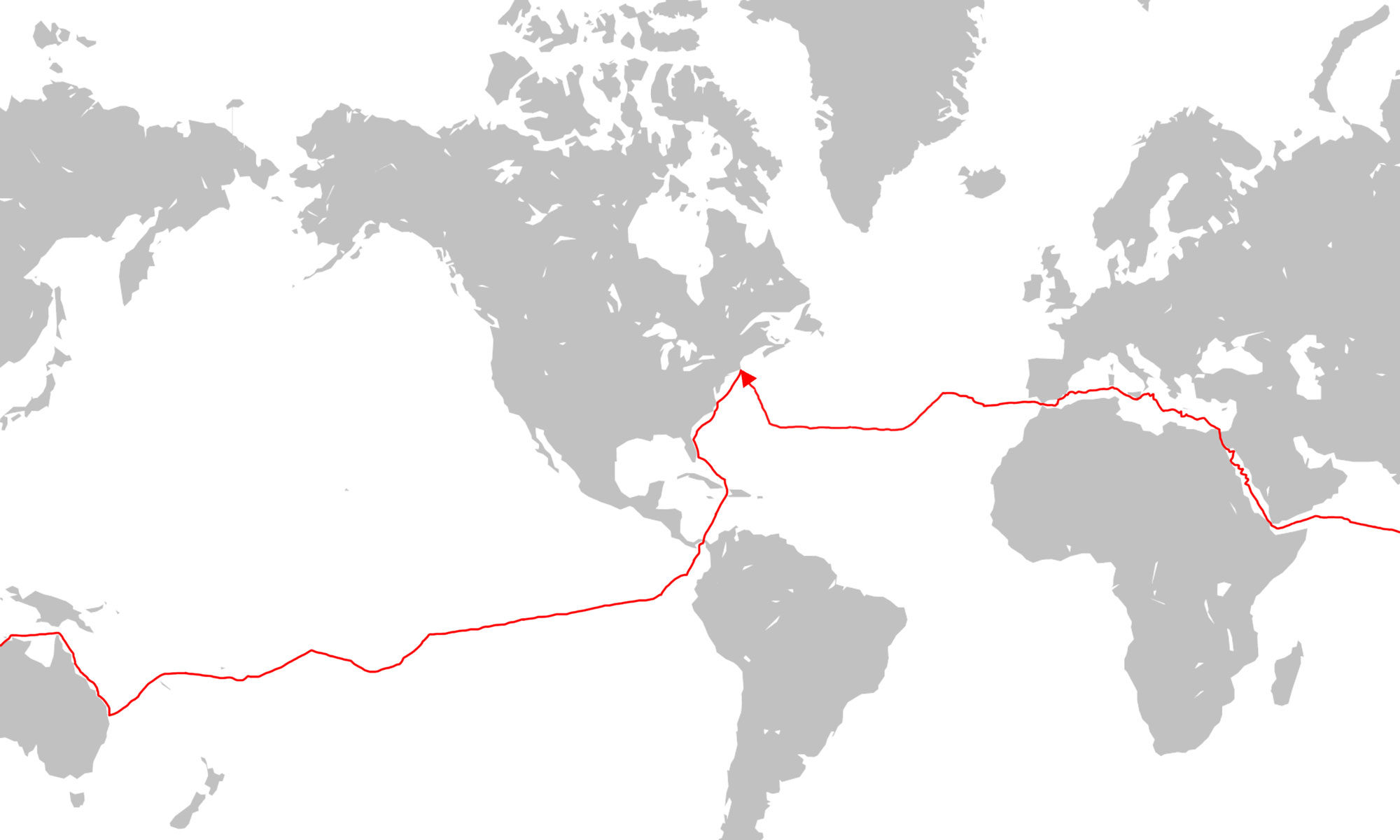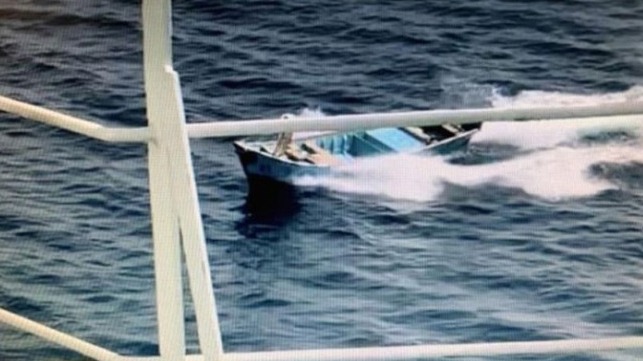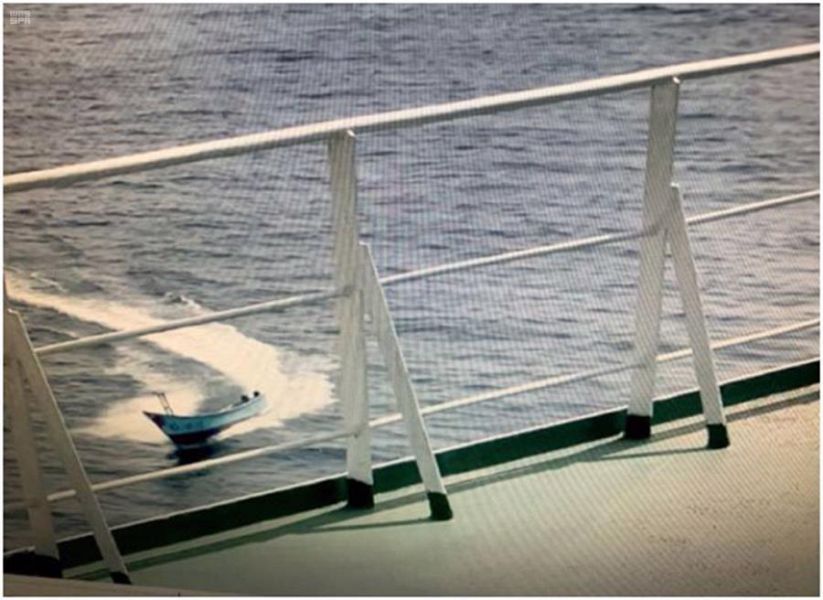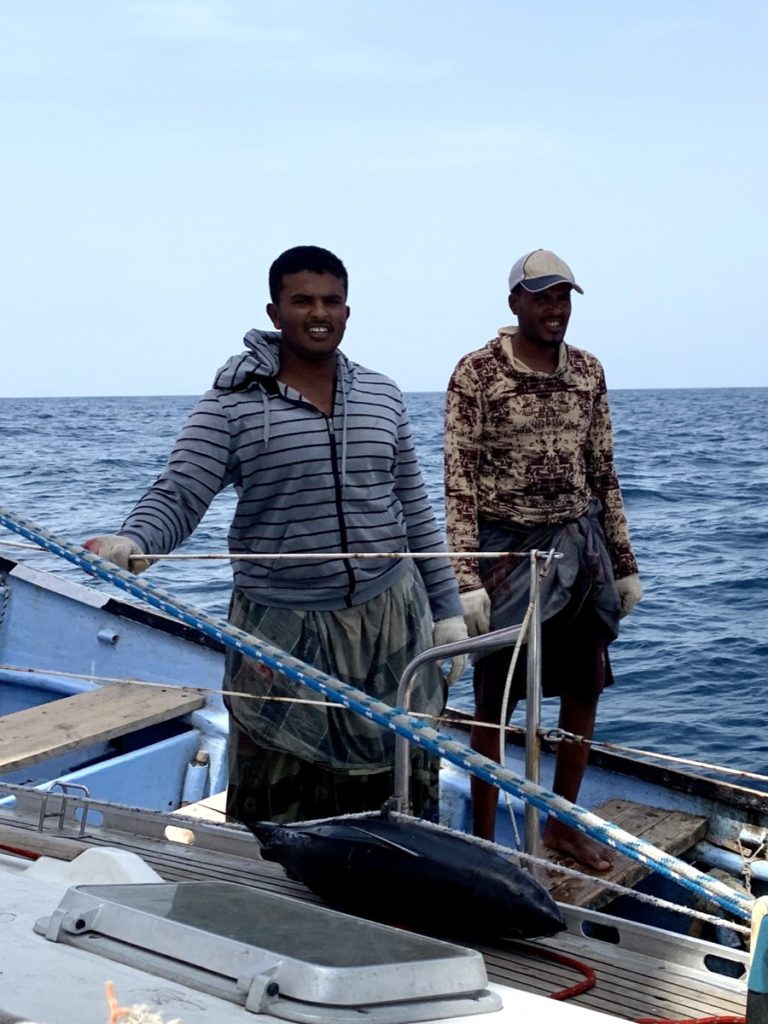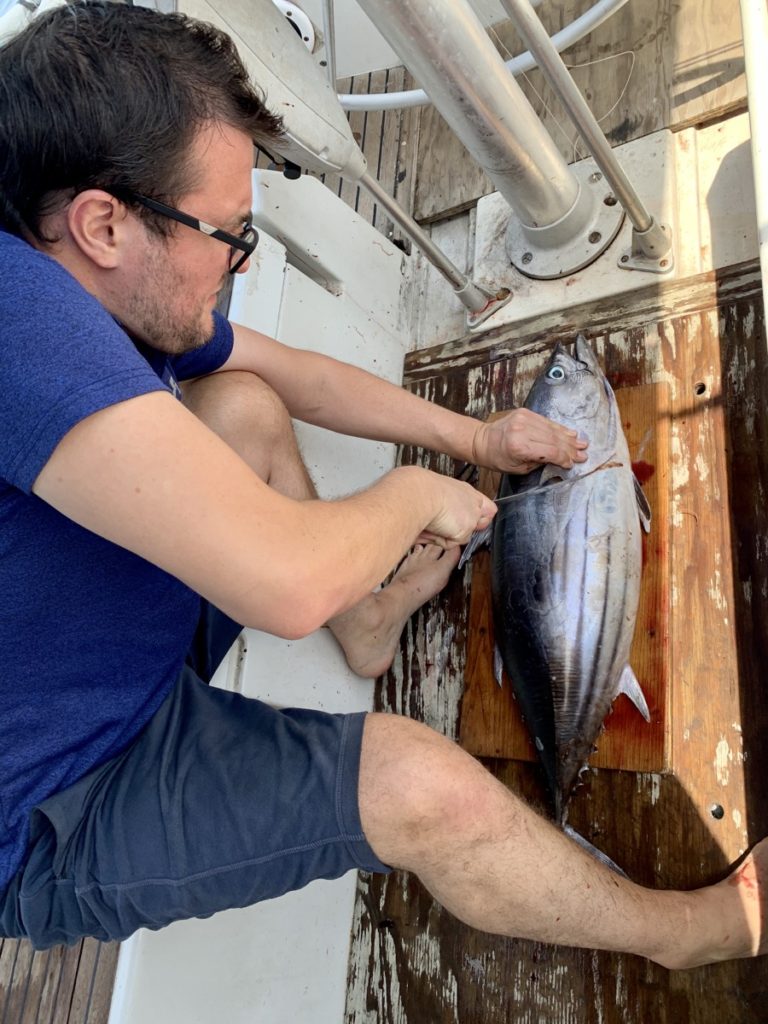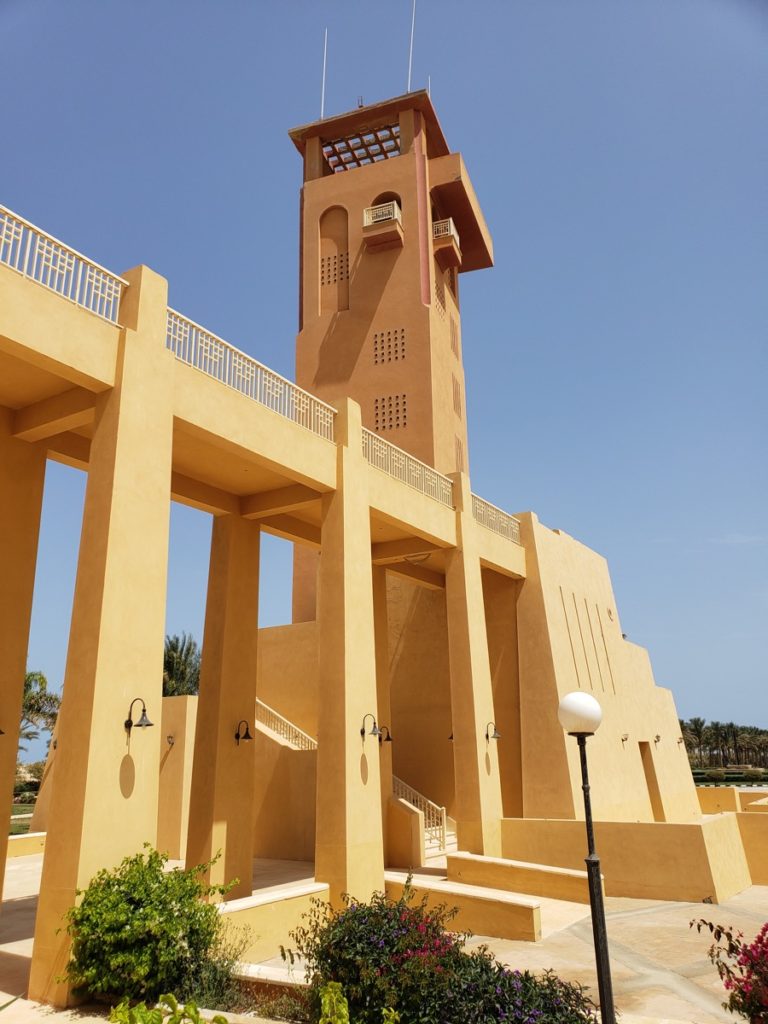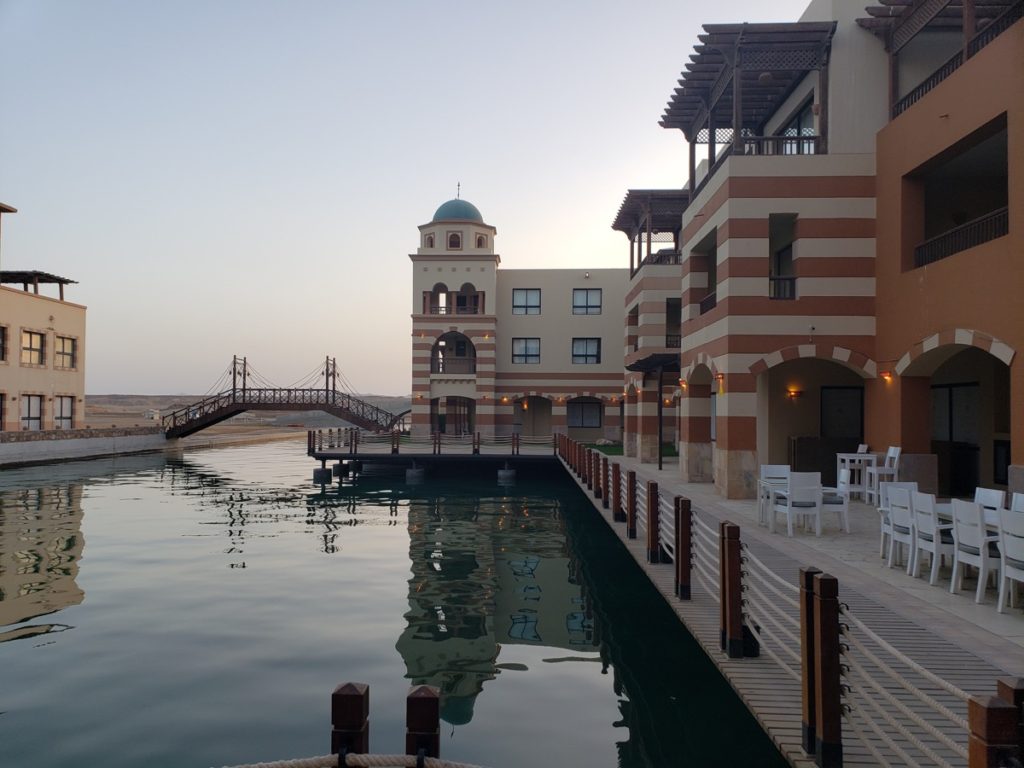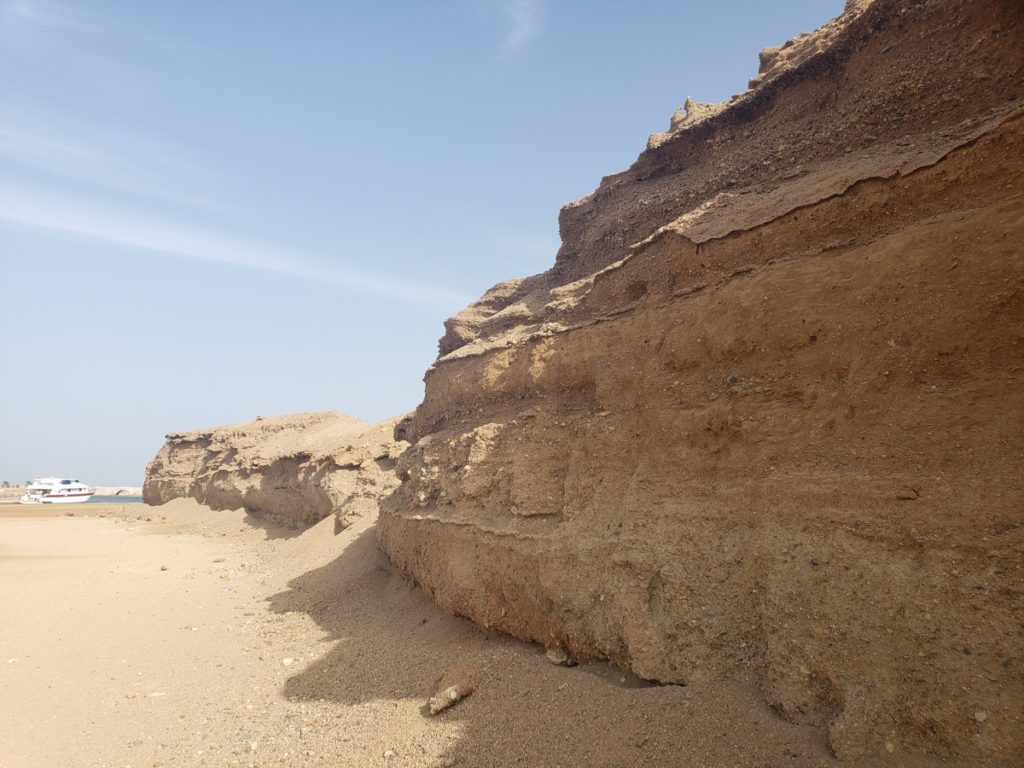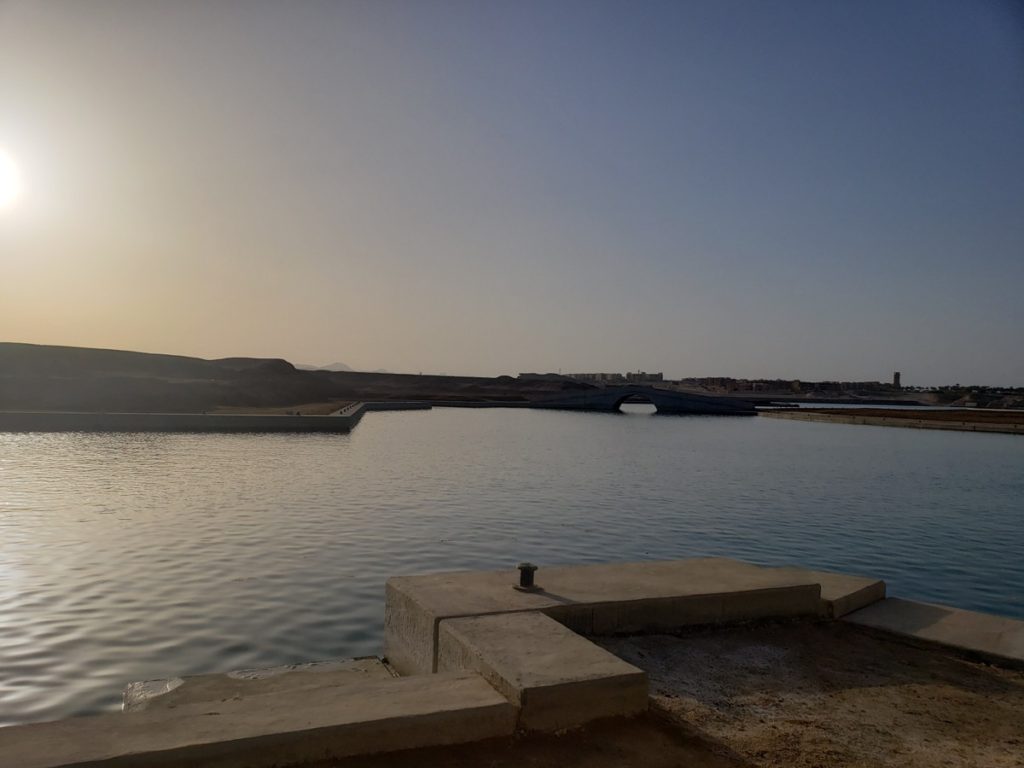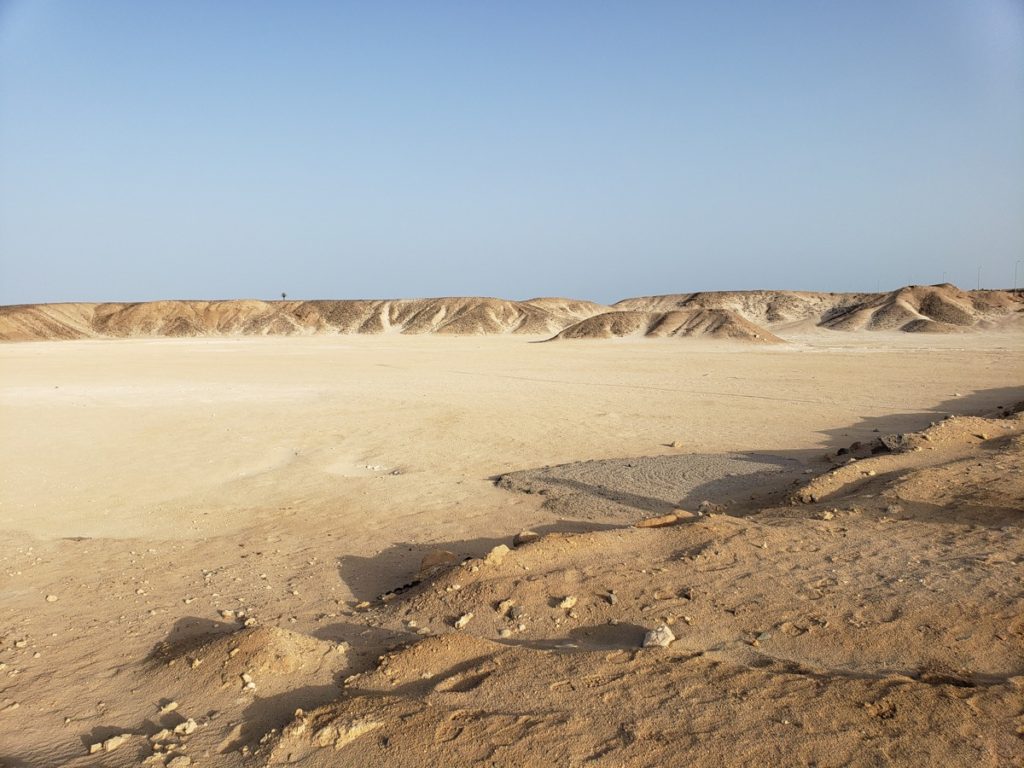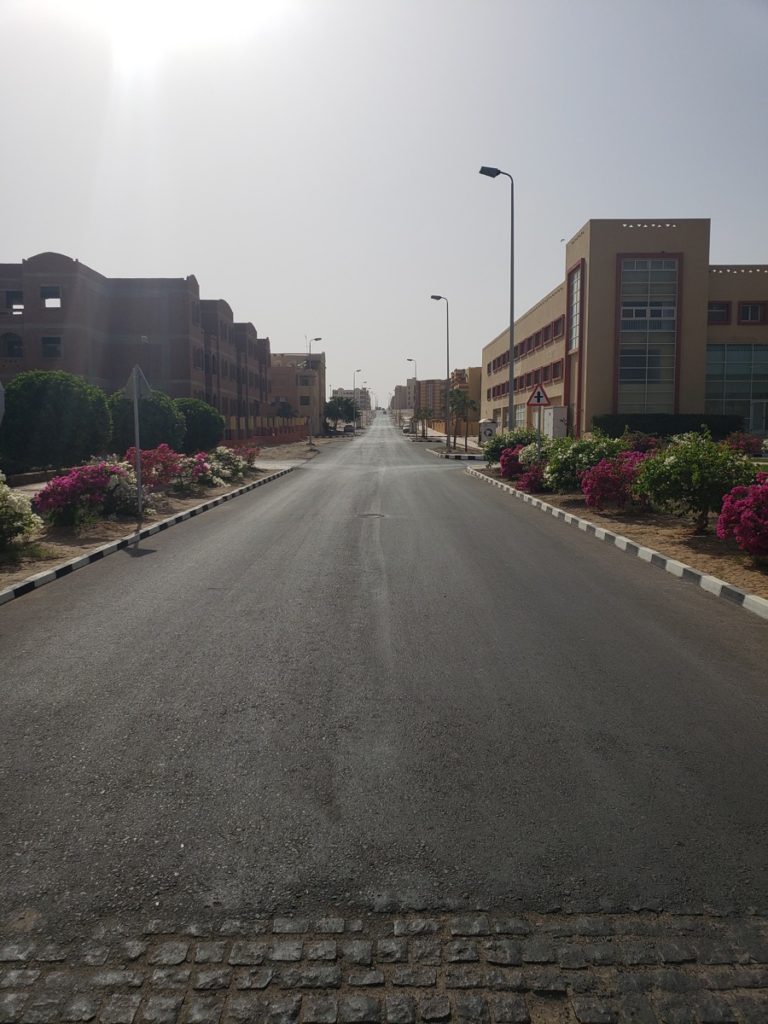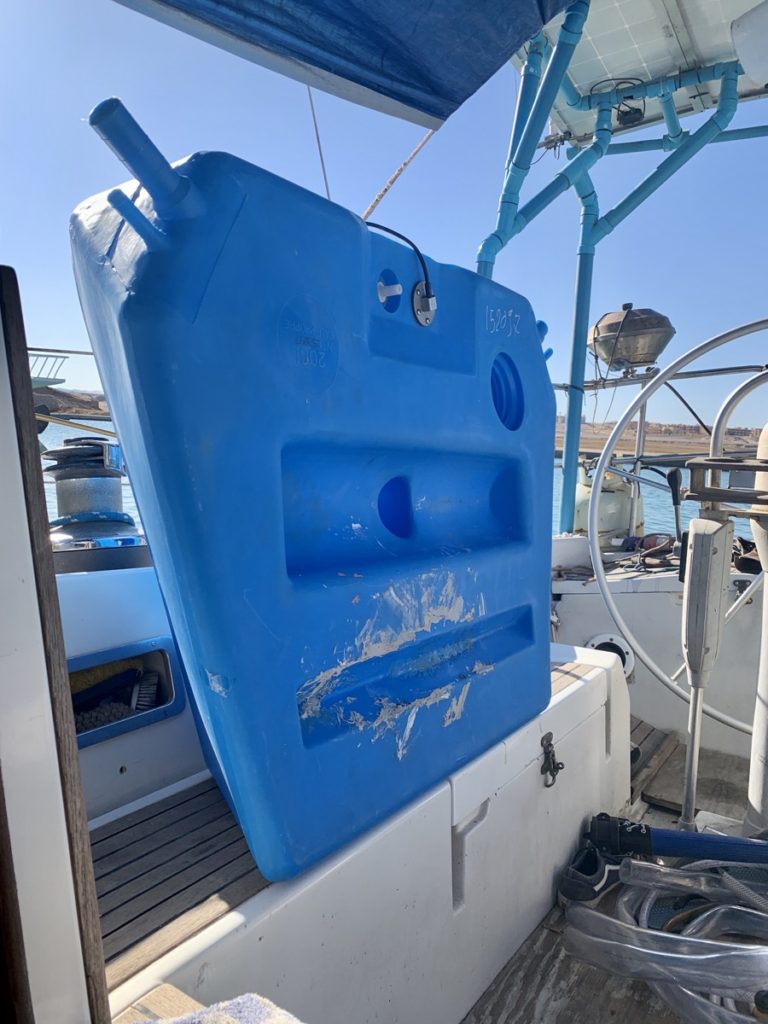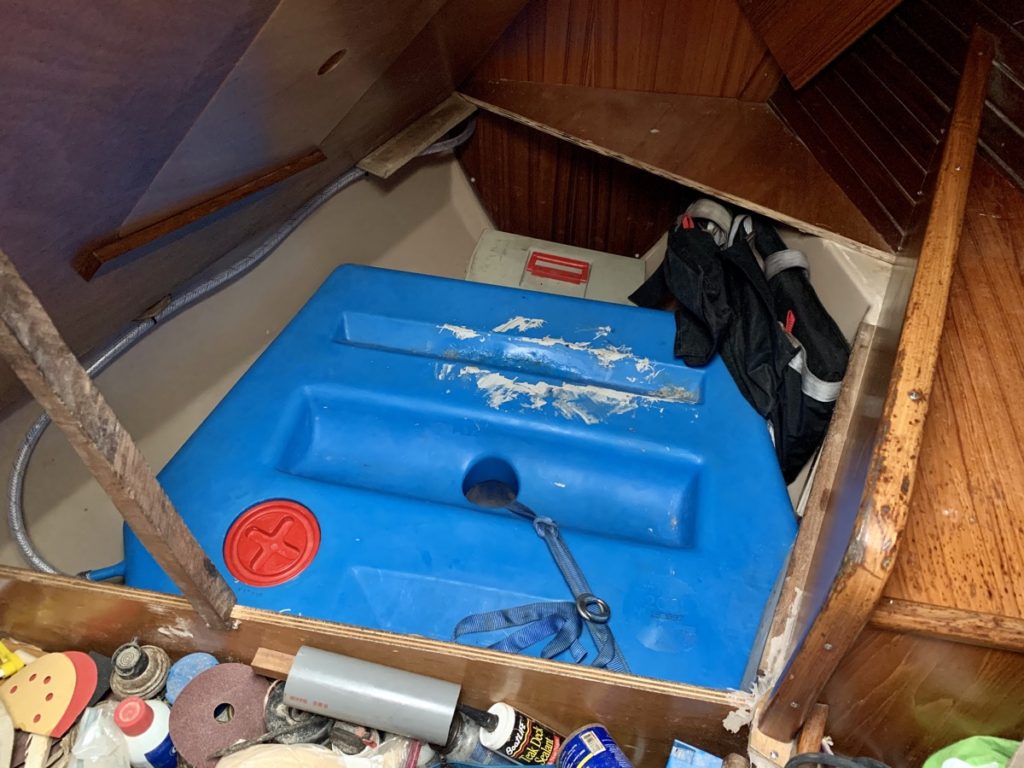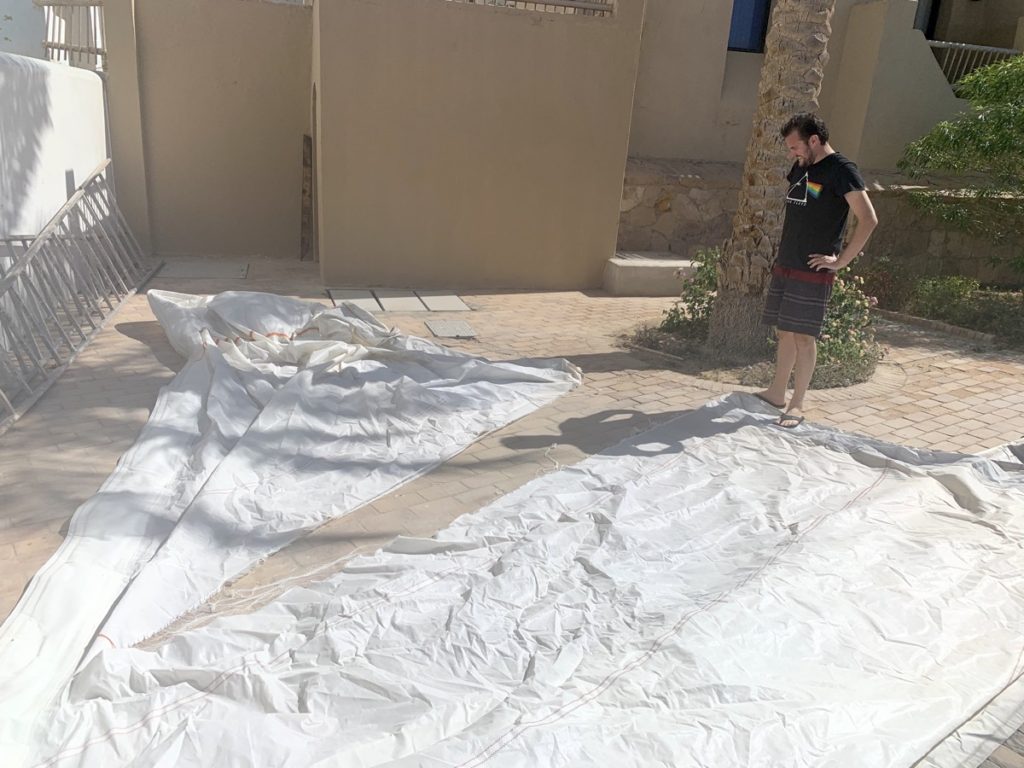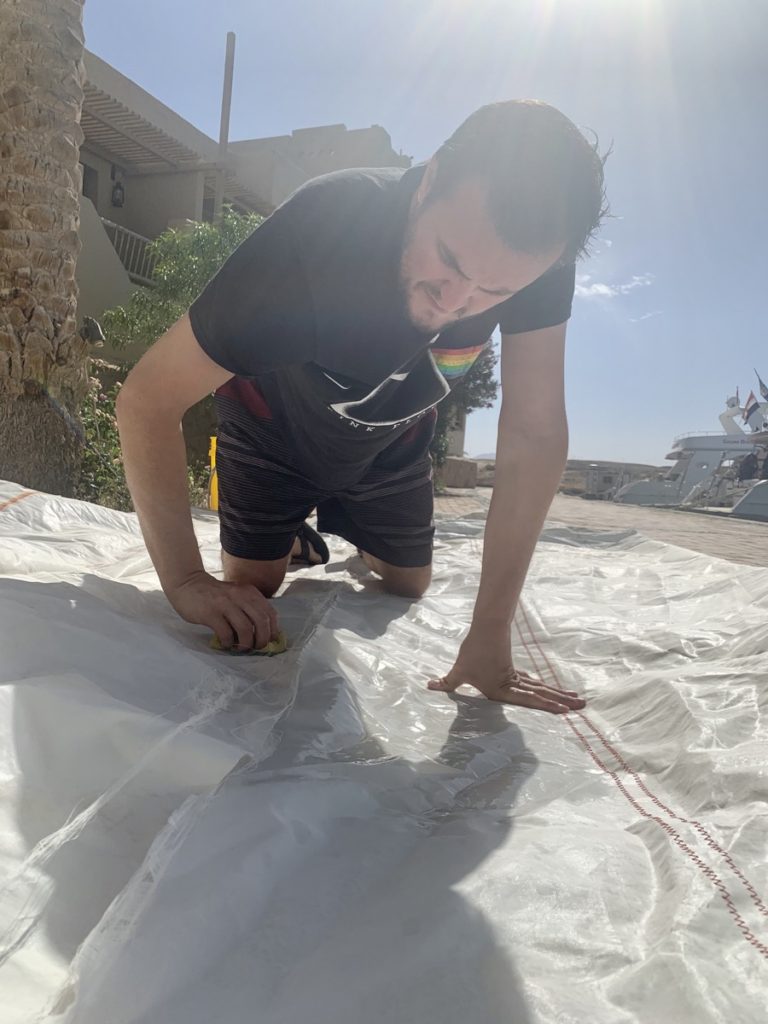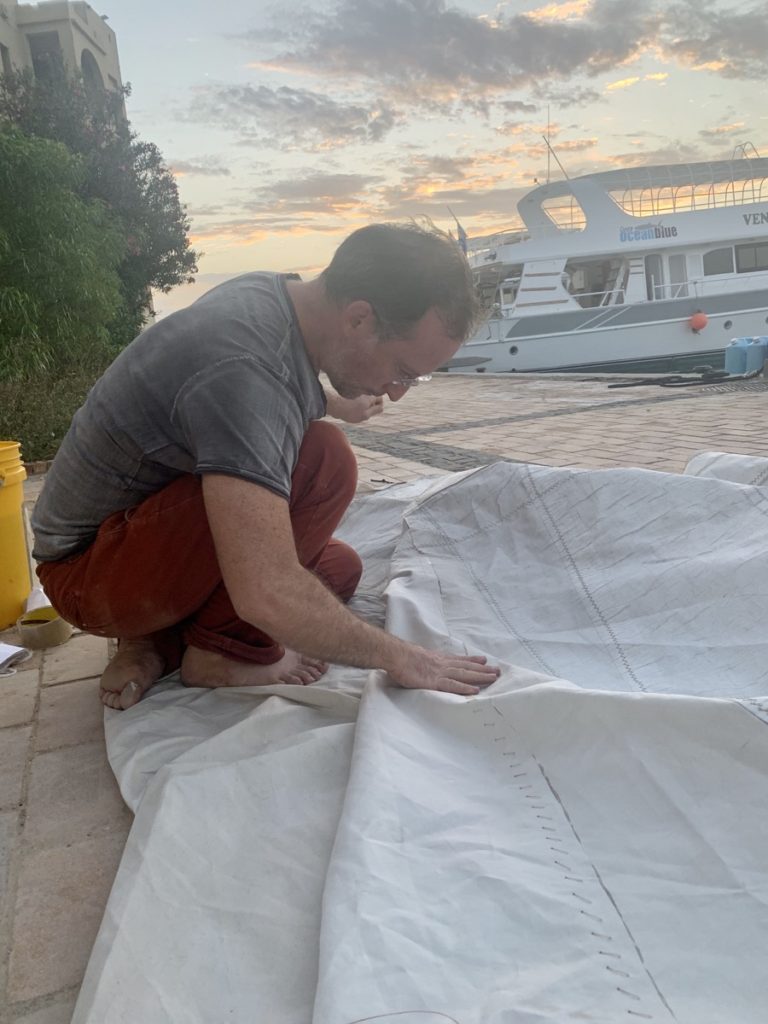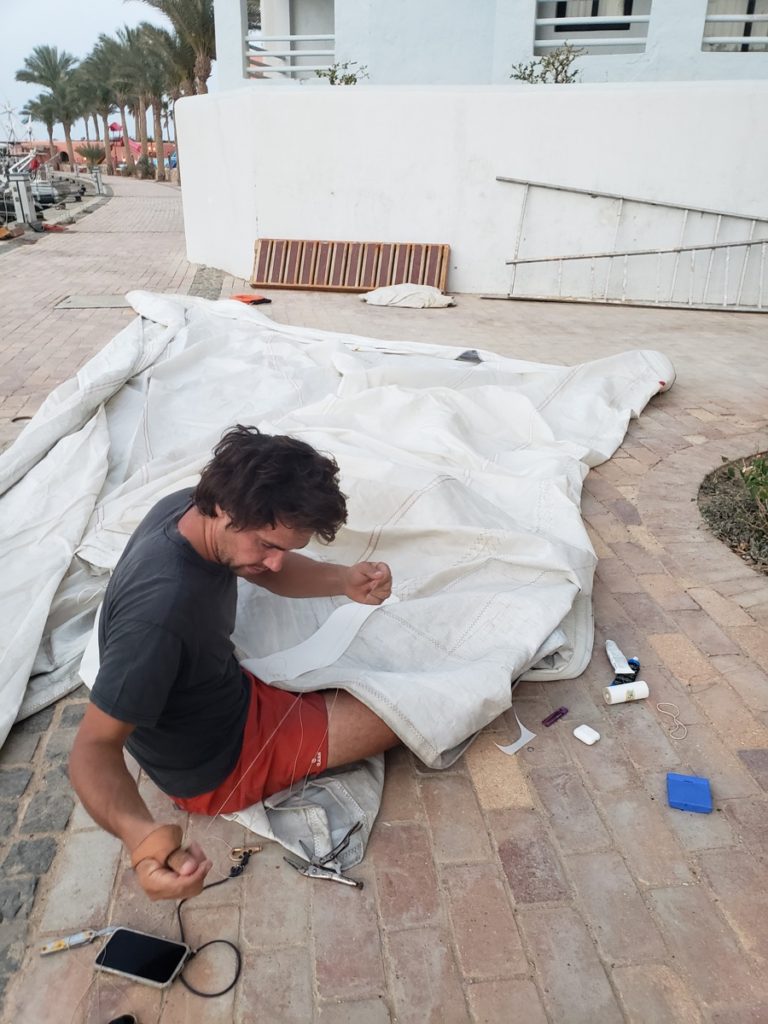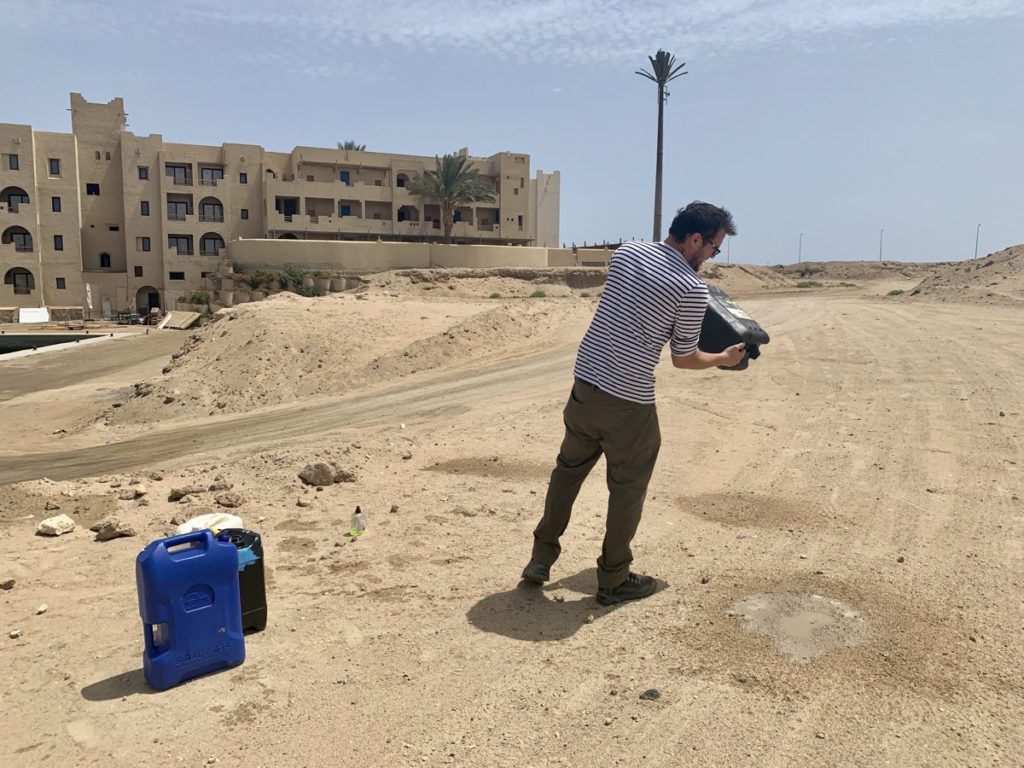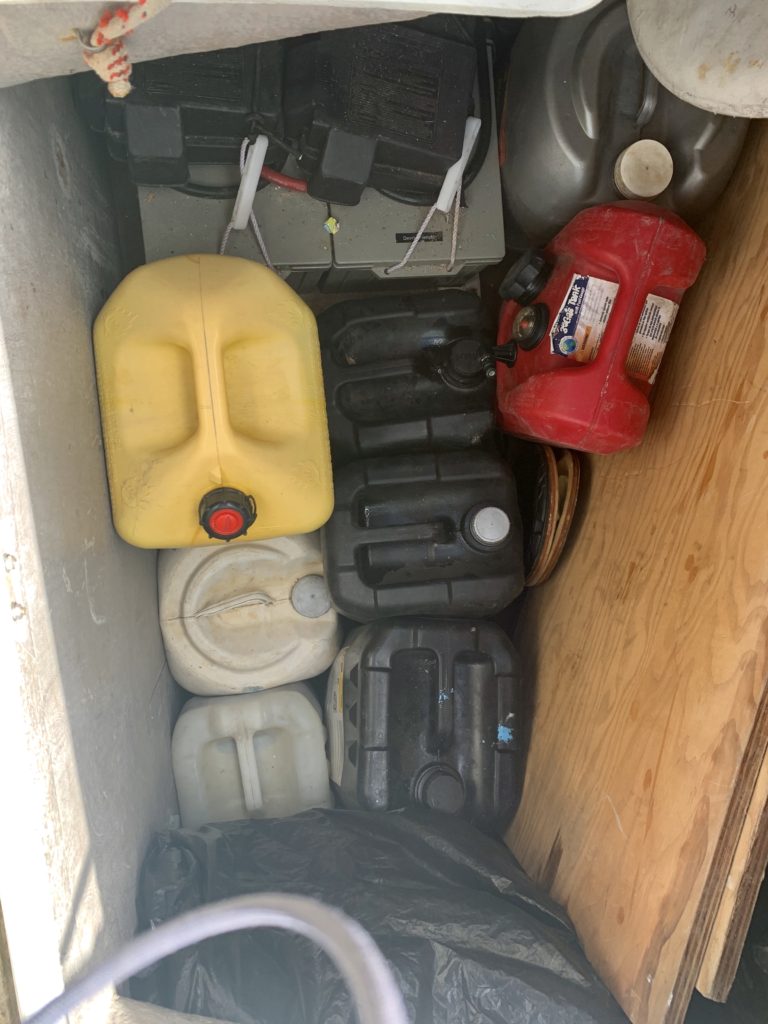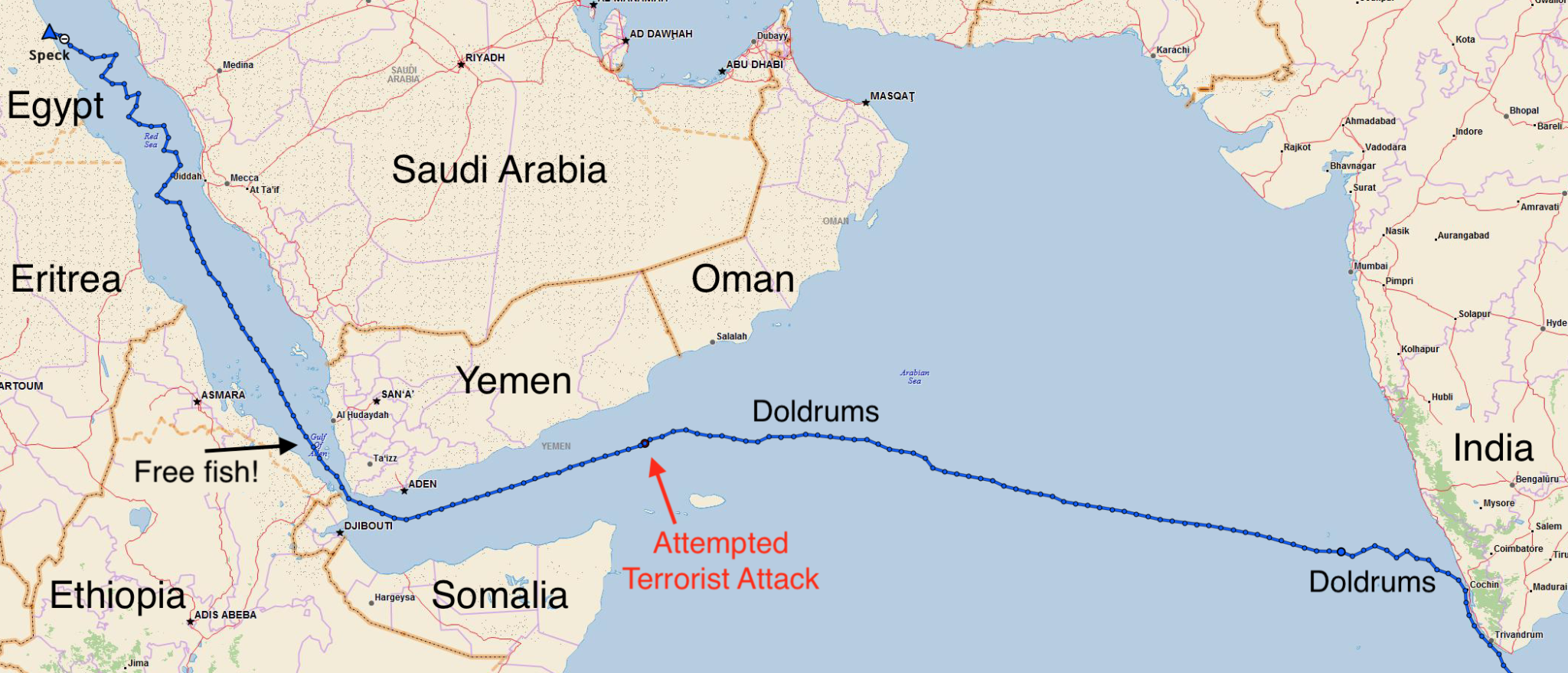
Sometimes when the wind is just right, you keep on going. Originally intended upon stopping in Djibouti, SV Speck and crew decide to keep going after crossing the Gulf of Aden. This made for a 35 day crossing – the most days at sea for for us to date. A good training run for what is to come.
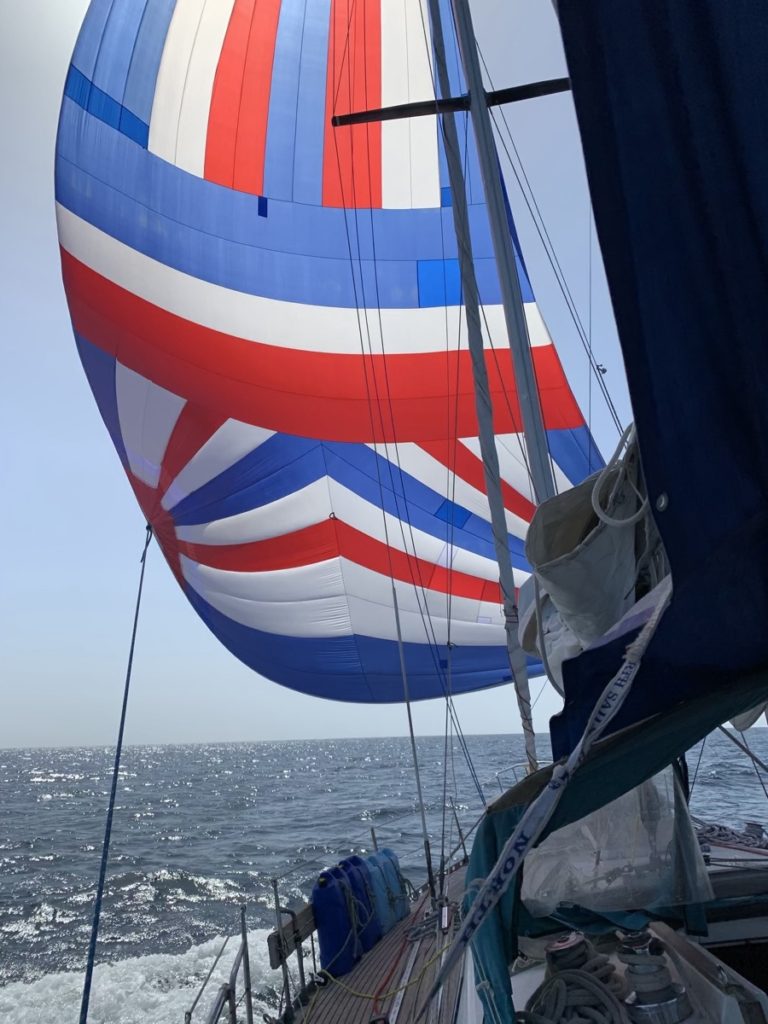
We left India with a nice stiff breeze that provided for some exciting sailing that lasted one whole afternoon. The next day we were properly greeted by what would be more common for this leg of the trip: doldrums.
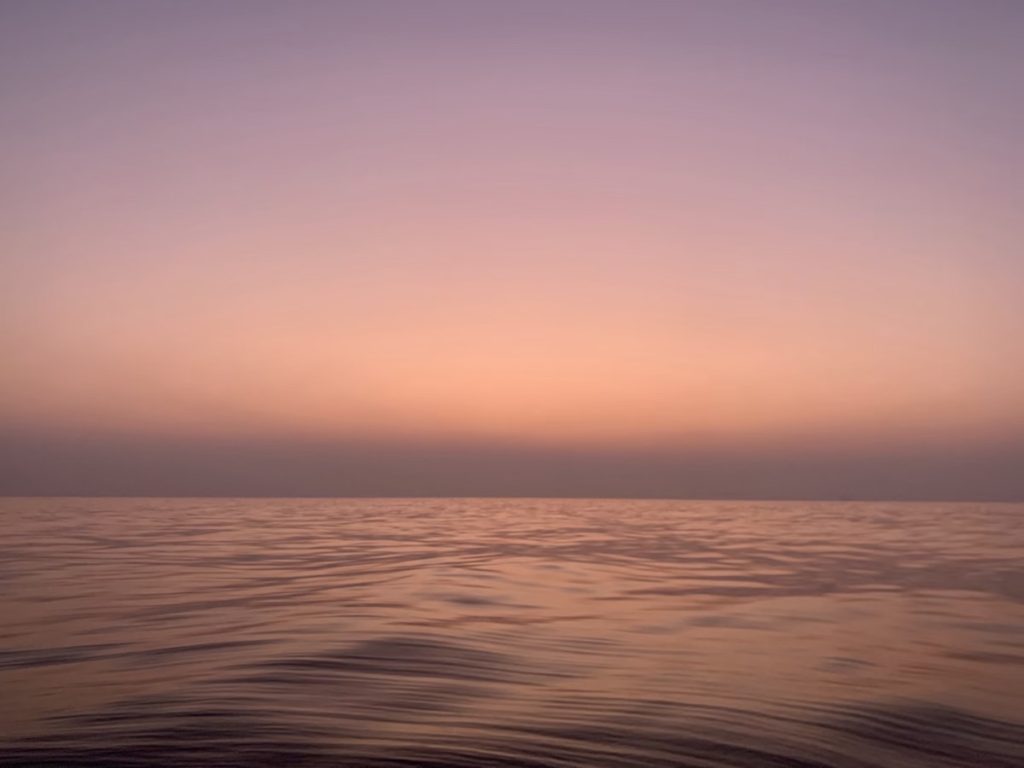
We have been in doldrums before, but this seemed to be worse. These lasted for days. In fact there were two straight days where we just didn’t have sails up at all and we just bobbed around in the ocean and played Minecraft below deck.
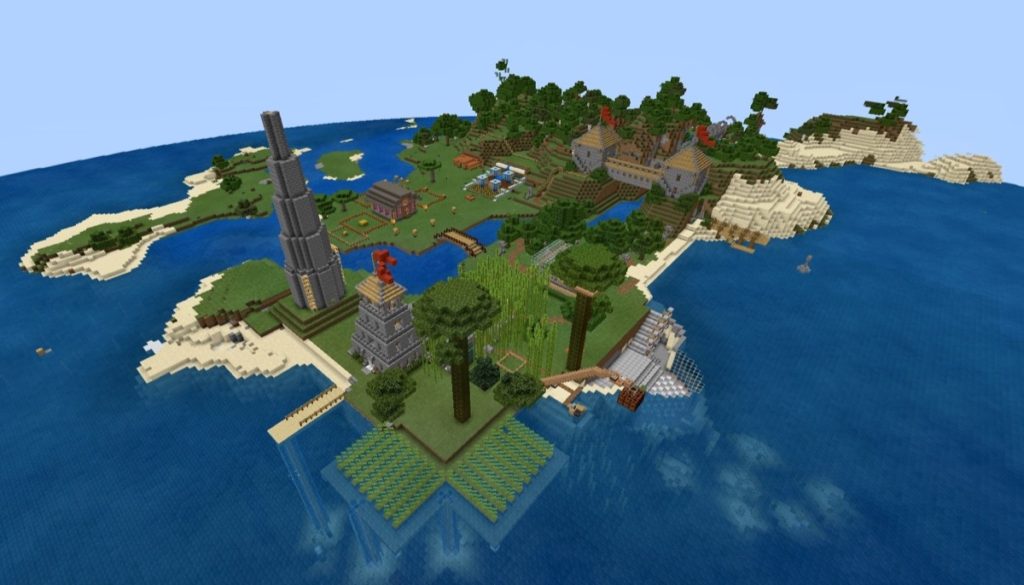
We finally got some wind that pushed us into the gulf of Aden and into the high risk area of our journey. This is the most dangerous part of the world to sail through as there is not only the most pirate activity but the most violent pirate activity. The best route to take is through the recommended transit corridor (RTC), a designated shipping highway that is regularly patrolled by coalition warships that check in with you daily.

As we entered the RTC, the wind died down. Flat ocean and zero wind. Very easy for a pirate skiff to close in very quickly. This was far from our minds as we were lounging above deck in the afternoon about 50 miles into the RTC as we heard a transmission over the radio from a cargo ship trying desperately to contact a coalition warship. “Coalition warship, this is cargo vessel ********* at GPS coordinates ********, we are being approached by 4 pirate skiffs, we have fired warning shots and they are still approaching.” and another call a moment later:
The calls for help were bone chilling. Byron recorded the transmission and played it back for the coordinates so we could see where they were. As we plotted their coordinates into our navigation software we saw that they were only 8 miles behind us and closing fast. It was a clear day so we looked aft and could see all of this taking place. Being an unarmed tiny sailing vessel we decided we were too vulnerable to stay here so we pulled in the sails and turned on the engine attempting to put distance between us and the situation. Unfortunately even with our engines, everything else out here is just much faster than us. Now the cargo ship and surrounding pirate skiffs were 6 miles away. Then 5 miles away. We began to push our poor little Perkins engine as hard as we could without risking damage. We were making around 6.5 knots. Still too slow to outrun anything. Then over the radio, “sailing vessel to our west, you have an inbound skiff”. We looked on as we saw one of the pirate skiffs break from the cargo ship and charge at full speed directly towards us. If the weather had been more rough, there might have been things we could do to shake them. Our boat can take far more weather than these little skiffs. But on a glass ocean, it was only a matter of time. They were closing in fast and would be on top of us in a mater of minutes. Byron set our Garmin device to SOS mode. We then got our flare gun out and a metal pipe. The skiff was now 1 mile away. With many thoughts going through our heads, Dan grabbed a knife and cut the American flag off our stern rails knowing there are militants who despise America in the area. He jumped below deck with the knife still in hand and tossed the flag aside and while doing so sliced his side with the knife. Just a scratch thankfully. Garmin emergency services messaged us back letting us know that forces in the area were aware of the situation. A coalition warship finally replied and would be there in 10 minutes. The skiff of course was much closer than that. We all jumped below deck, contemplating locking ourselves in somehow. The skiff was seconds away now and not slowing. We agreed that we were getting boarded and there was nothing that could prevent this but before we had time to decide anything else the skiff was 50 feet from our boat. It still has not slowed down! The skiff lightly rubbed the side of our boat and sped off into the distance. There was no one on it! Just a camera! A remote controlled scout skiff, or so we thought. A few minutes later we heard a loud but deep rumble off in the distance. Thirty seconds later “all ships in the area be advised of a skiff on fire.” It would seem that coalition forces destroyed one of the skiffs. Sometime later, after we arrived in Port Ghalib, we learned the chilling truth that the skiffs were not pirates, but militants attempting to carry out a terrorist attack against Saudi Shipping. The unmanned boat was actually a remote controlled bomb boat. Either the detonator failed or they wanted a juicier target. Either way lucky stars were counted that day.
https://www.maritime-executive.com/article/saudi-forces-report-attempted-bomb-boat-attack-on-tanker-off-yemen
Most pirates use these fast moving wooden skiffs to attack cargo ships. They are unfortunately the same boats a lot of the friendly local fishermen use. Days later, as we entered the strait of Bab El Mandeb just off the Yemen coast, we sailed into a group of about 15 skiffs exactly like the ones involved in the attack a few days prior.
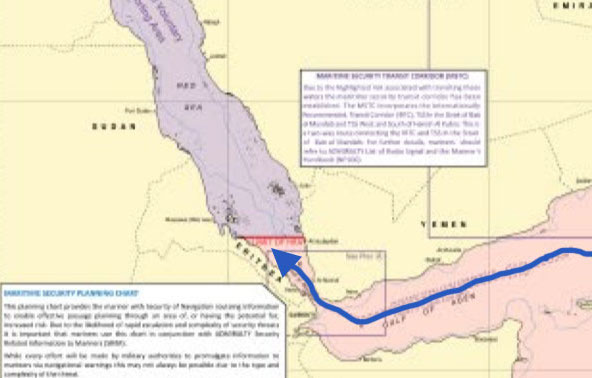
We tried to keep our distance but there was so many of them and two of them sped up to both sides of our boat. Holding onto our rails they greeted us with smiles. No guns visible, that is a good sign. They asked us where we were from. We nervously replied “Canada”, still not wanting to give away that we were Americans. They replied “Texas?”, we said no. After some more polite chatter the tension slid away as we saw clearly that the bottom of their boats were filled with freshly caught tuna. One of the fisherman grabbed a particularly large tuna held it up and asked us if we fish. We told him that we do indeed fish but it has been a while since our last catch. He then slapped the massive fish down onto our deck and said that this was a present for us. We asked him if we could give him some money in exchange and he absolutely refused and in fact gave us a lure and some line that he assured us would catch us some tuna. After a few more minutes of friendly banter they let go of our boat and were off.
Josh got his first experience in filleting a fish. He did quite an excellent job. In a short time he had turned the fish the Yemeni fishermen gifted us into a fine dinner as well as dinner and lunch over the next three days.
They say the ocean is a desert, and yet we never seem to be without our own wildlife show. We had this one peculiar bird we have yet to identify hang out with us for a couple days taking breaks from its long flight. We have never seen anything like it. Can you identify it?

How this grasshopper got on board, I will never know. Nonetheless we will add him to our SV Speck wildlife archives.

Without breaking form or pattern, we were greeted into the Red Sea after leaving the high risk area by a very playful pod of dolphins. Signifying a positive change of conditions, the dolphins put on a fine arial display, jumping high into the air executing graceful flips.
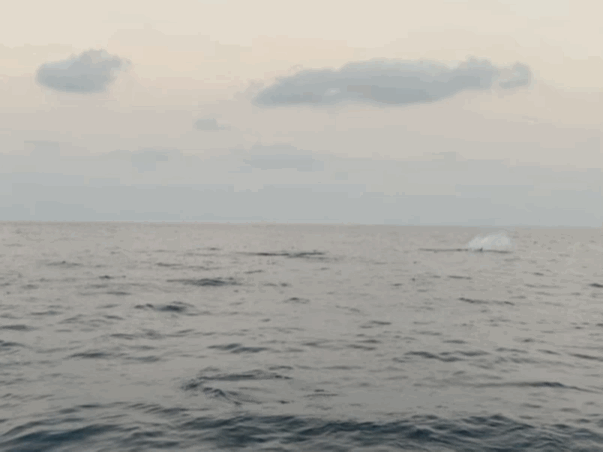
The first half of the Red Sea was a delightful downwind sail, softly gliding down gentle rolling waves. This was interrupted by a short doldrum followed by a 180 degree shift in the wind for the rest of the trip. We needed to sail Northwest toward Ghalib. The wind predominated for the rest of the trip from the Northwest requiring us to execute some of the most precise, albeit, uncomfortable upwind sailing we have seen in quite a while.

With our running rigging pulled in as tight as it can go and with the wind gathering strength, a building strain was put on our standing rigging.
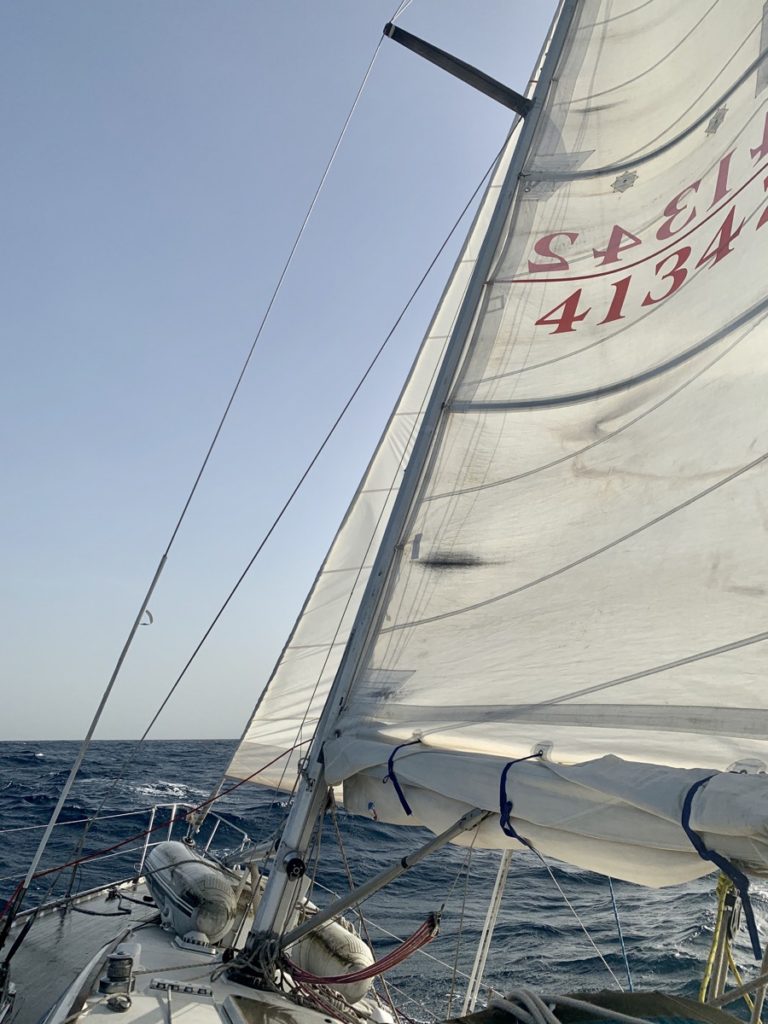
We were all down below when we heard what sounded like a bucket of rocks slam to the deck. Dan poked his head up above deck and was convinced it was just something shifting in the galley. Thirty minutes later Josh, through a more thorough inspection reported that there was a long steel cable laying on deck. One of our running backstays had snapped. Thankfully this was not a crucial piece of standing rigging and the mast didn’t come crashing down. Josh took the wheel and we dropped the sails and pointed downwind, just letting the waves and the wind on the hull gently push us through the water. Byron hopped in the bosun’s chair and Dan hoisted him up the mast with the big winch we use for the larger sails. We use multiple safety lines when we do his to protect the person up the mast. Even so, this is a terrifying procedure at sea for every foot you are swaying back and forth on deck, the person up the mast sways 4. In typical form, Byron had everything patched up stronger than before in about 45 minutes. We were quickly underway and making up for the distance we had drifted off course during the repair.

A terrifying place to be up the mast on the ocean, yet offers a rather stunning view of our beautiful home.
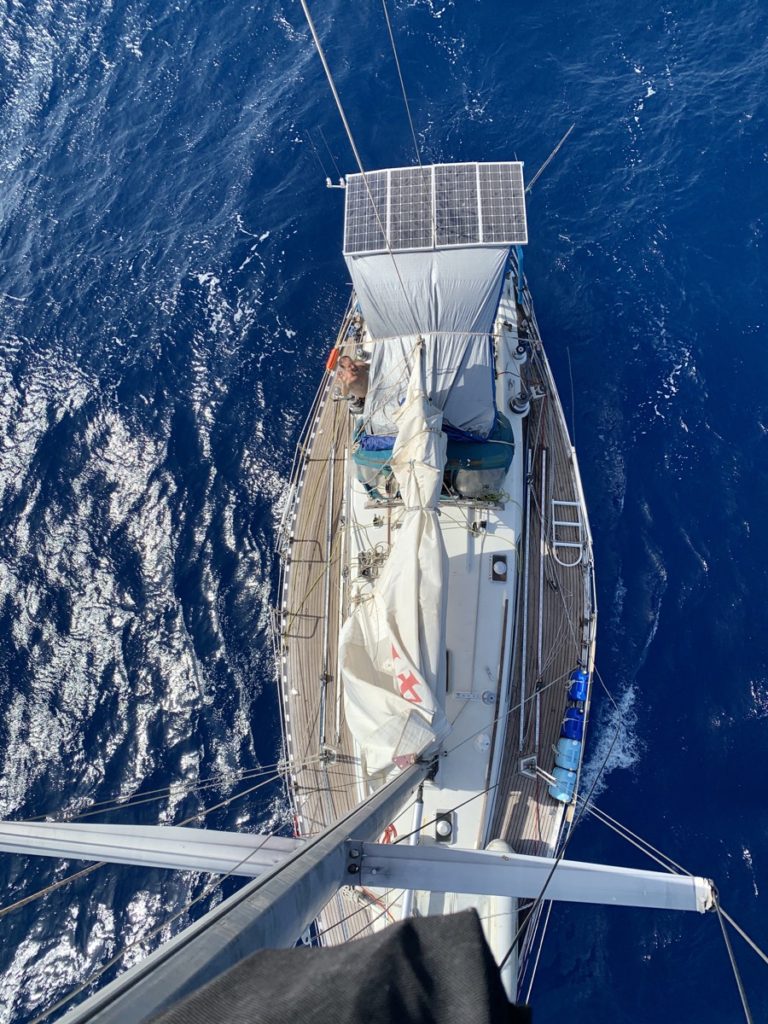
As we closed in on Port Ghalib just a few days away, we tuned back into the news via our FM radio to see about updates about the coronavirus. We hadn’t heard much on this front for weeks. We were not prepared for what we were about to hear. But alas we were still happy that Port Ghalib was still an option to us.
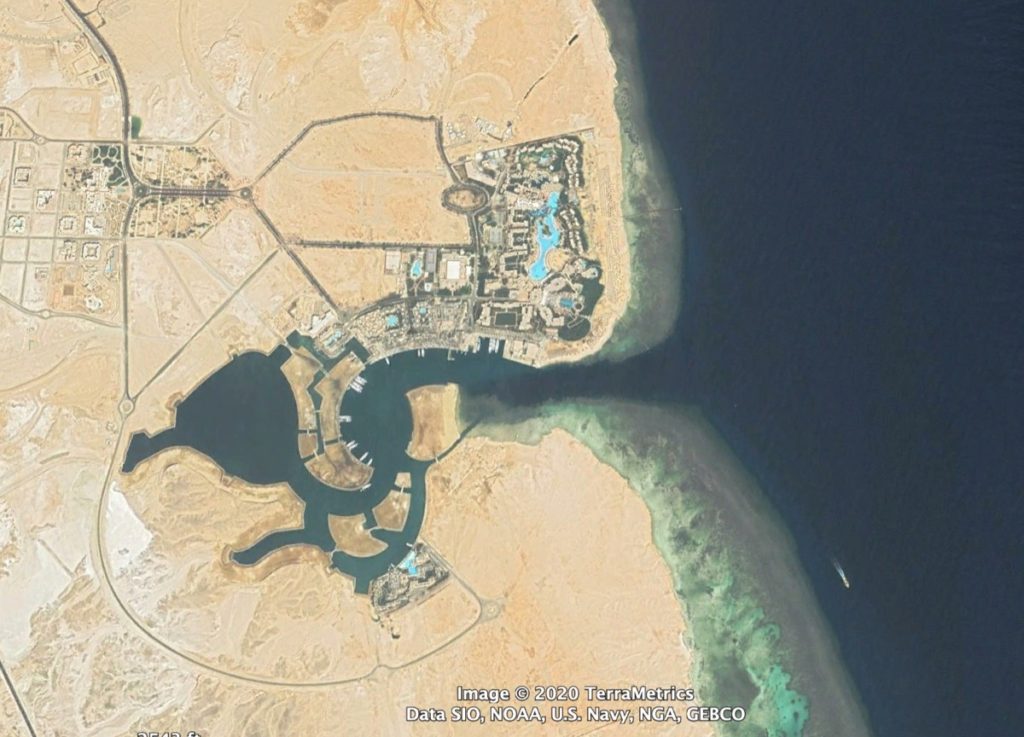
They say a rolling stone gathers no moss. As you can tell from the growth on Specks hull, this is not always true. Once a couple days rested in this oasis we went right back to work getting things fix, preparing for what could possibly turn into a 2 month crossing all the way back to the states. We made good friends with our neighbors Hermen and Marjolein aboard “Messenger” during our stay. We exchanged food, movies and our own personal stories with them in the weeks we spent in Ghalib. They have a wonderful youtube channel here:
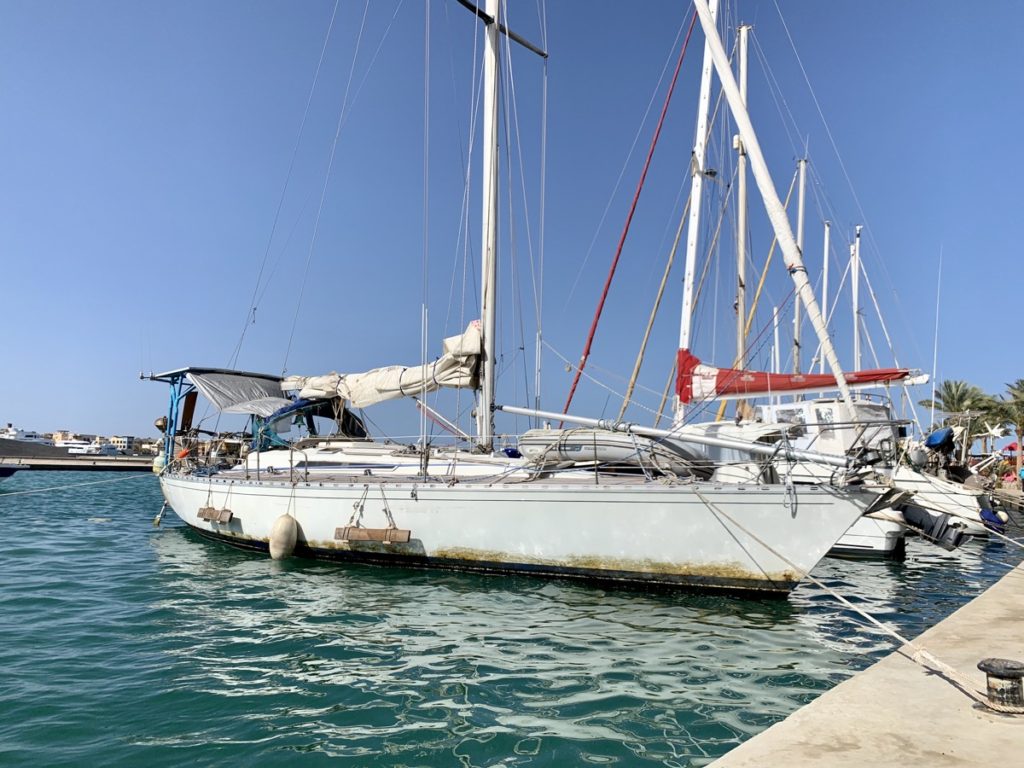
Ghalib was surrounded by dessert. It was almost like being on another planet. The barren surroundings paired well with the somber atmosphere of quarantine.
One of our neighbors gave us a free broken water tank! One plastic weld repair later and we had an extra 200 liters on board for our long crossing. What a find and what a price!
Nothing stops the crew of SvSpeck! After not finding a sail maker to do the repair, we decided to do the repair ourself. A clean tear going across the whole length of the middle of the Genoa. We used sail tape and a triple triangle stitch down the entire thing with extra reinforcement patches for high load areas. Doing this by hand was truly strenuous. Working continuously from sunrise to sunset, we finished the task in one and a half days.
We bought some used oil jugs we repurposed as additional diesel jugs. Now we have a potential 600 mile motoring range. This will be important as we expect some hard sailing days ahead.
Our intended route now takes us through the Mediterranean, sailing south of Crete then possibly through the strait of Messina to give us a slight advantage over the strong northwesterly winds that blow out of the alps. From there we sail to Gibraltar and attempt to refuel and rewater, as well as reassess our situation and can make the decide if we can make the Atlantic crossing and be stateside by June 15 and miss the hurricanes. If we can’t make the crossing we will amble about that side of the Mediterranean in search of a place to set down for a few months while we await our next crossing window sometime in October or November.
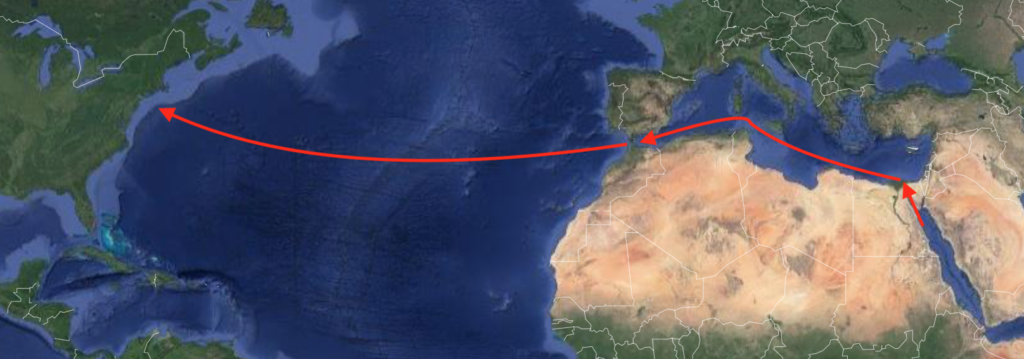
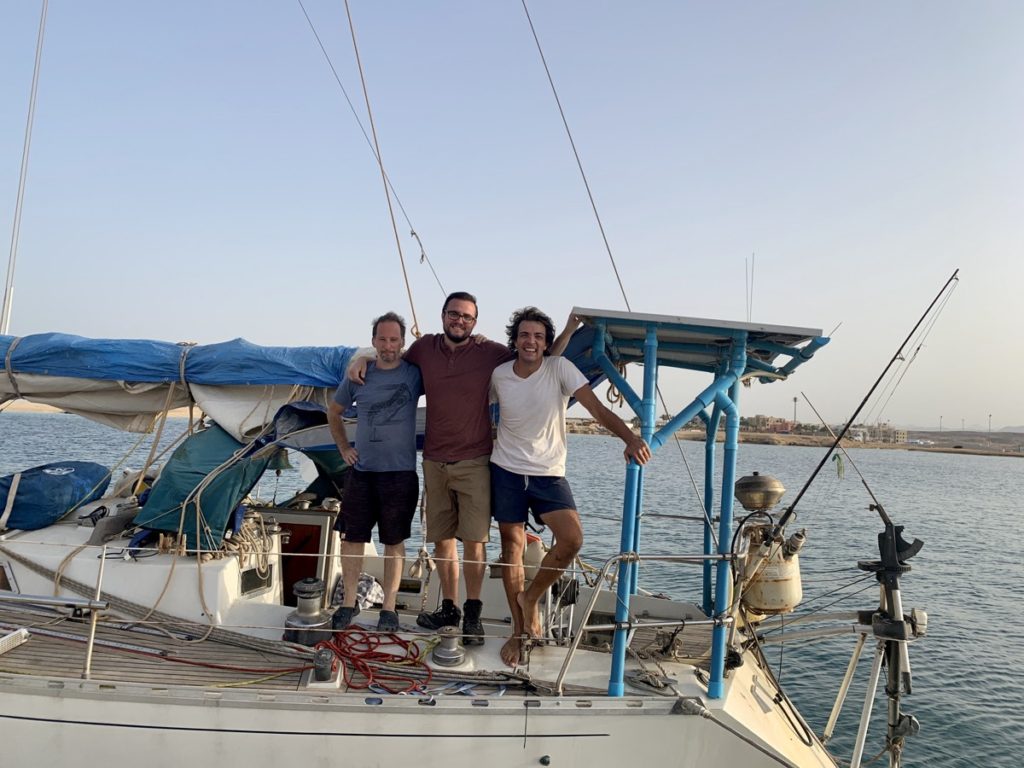
Follow us on the live map:
